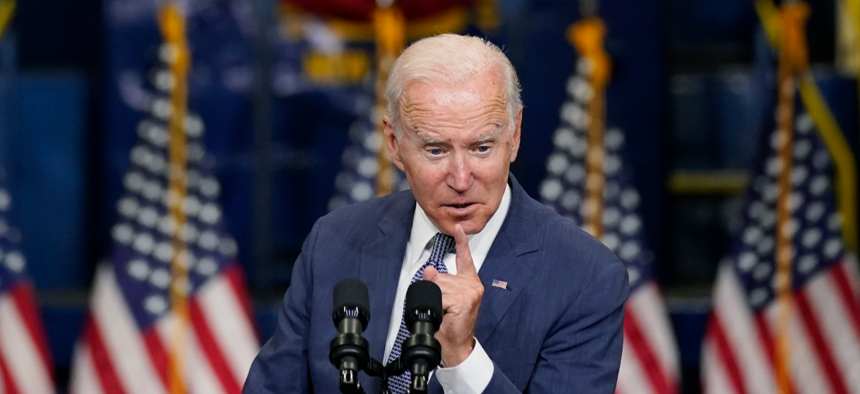
Evan Vucci / AP
Why Biden’s Presidential Management Agenda Is a Big Deal
The sharply focused effort places a high priority on employee engagement.
The release of each new administration’s president’s management agenda predictably raises the question, “Is this a big deal?” For the new Biden PMA, the answer is a clear “yes,” in subtle and surprising ways.
The new PMA builds on four previous efforts: Clinton’s “reinventing government,” which promised “a government that works better and costs less”; Bush’s 14-point plan and his introduction of the Performance Assessment Rating Tool; Obama’s agency-based approach to build success in federal programs across the country; and Trump’s plan of interlocking gears—information technology modernization, data accountability and transparency, and a federal workforce for the future.
With this 20-year history, it’s impossible to be a serious president without carving out a major—and different—slice of the management issue. Performance.gov has become the key source of continuity for the federal government’s management. But each president wants to put a new stamp on dealing with the federal government’s considerable management challenges.
Compared with previous PMAs, Biden’s strategy is hyper-targeted on just three cross-cutting areas: strengthening the federal workforce, delivering a better customer experience, and improving the federal management processes for grants and contracts. Earlier PMAs covered far more territory. The Obama targets, for example, stretched across 16 different cross-agency priority goals. Biden’s PMA is far more focused.
And that sharp focus sets up four “big deal” elements of the Biden PMA.
First, the federal government’s chief managers signed on, quite literally, to the PMA, with two pages at the very end of the document. Unlike previous PMAs that typically had a top-down feel (except for the Obama PMA, which put more responsibility on agencies to define their own targets), the members of the President’s Management Council—deputy secretaries or the chief operating officers of the federal government’s departments and agencies—added their signatures at the end of the document.
This brings collective support from across government to the PMA, as well as a personal commitment by the government’s chief managers to advance the agenda. The big question that typically surfaces after the release of the PMA is, “Good ideas—but will the agencies buy in?” The two pages of signatures answers that question, although what priority the agenda gets inside the agencies amid the tug of ongoing policy issues remains to be seen.
Second, for federal employees, the PMA commits top government executives to engaging them far more effectively in the work of their agencies. There’s never been as powerful a focus on employee engagement in other PMAs as in this one. Nor has there ever been as clear a warning about the need to improve engagement, since the report points to how far the federal government lags private industry in engaging employees.
The report points to the urgent need of the federal government to recruit younger workers more effectively, especially since the share of the workforce under age 35 is twice as high in the private sector. With Boomers steadily heading to the door and with the need for skilled federal workers in STEM and data sciences growing, this is an existential issue for the federal government.
Third, for citizens, the PMA commits the government to a far stronger effort to improve customer service. Of special importance is a small note in the report about organizing the federal government better to address life events—like, births, marriages, retirements, and deaths—that bring intensive involvement with a host of government agencies. This is a fundamental and important shift in the federal government’s customer-service efforts.
Citizens dealing with those events often must touch base with many agencies dealing with related issues, often sharing the same information. In fact, as one recently retired friend of mine pointed out, “retirement isn’t for wimps,” given the challenges of negotiating Social Security, Medicare, and the host of other government-related retirement issues. The PMA anticipates making citizen-facing interactions easier and more transparent while creating back-office channels to connect the information that agencies need to complete their work. Life-event government has been an important part of reforms in countries as wide ranging as Australia, Estonia, Malaysia, and Slovakia, and it could vastly improve citizen satisfaction with the federal government.
In many parts of the federal government, there’s often strong push-back to the idea of customer service as a driving element in the agenda. “We don’t interact with citizens and, therefore, we don’t have customers,” is the response. But everyone—everyone—who works for government is there ultimately to serve citizens. Sometimes, as with Social Security, that connection is direct. Sometimes, as in the Federal Aviation Administration’s air traffic control mission, it’s indirect. And sometimes, in programs like contract management and grants management, it’s facilitative to other parts of the government that connect directly with citizens. For everyone, the PMA is a call to remember who pays the bills and for whom the government exists. And that provides a basic language for dealing as well with an important part of the PMA, “advancing equity,” that is everyone’s business. This is a fundamental redefinition of accountability, as government connects with citizens.
Finally, and most important, the PMA anticipates a convergence of engaged employees and customer service. It’s not a matter of engaging employees as a process separate from program management but, rather, focusing all their work on the needs of their customers, from the citizens’ point of view. It’s not a matter of establishing a broad principle of customer service but, rather, using service to citizens as the prime driver of employee engagement.
This link is a quantum leap in the federal government’s management strategy. It answers the questions of “engagement—for what?” and “customer service—how?” It reshapes accountability by moving away from process to focusing on results that matter to both employees and citizens. It creates an opportunity to earn trust, since much evidence points to the retail-level connections between service providers and recipients.
In short, the PMA creates a chain of accountability from the president to his political appointees, from the appointees to federal managers, and from them to federal employees and ultimately to citizens. The combination of the direct link to citizens, coupled with the personal responsibility that the president’s appointees have agreed to own, marks a revolutionary turn in the PMA strategy.
There are lots of questions that will need to be fleshed out, from the ways that supervisors will advance employee engagement and connect it with customer service to the broader challenges of workforce recruitment, retention, and management. It would take a document three times longer to sketch that out—and it will take lots of careful thought to fill in ideas that are just in their infancy.
But to the question, “Is this a big deal?”, the answer is unequivocally yes. As Washington yet again sinks into the mud of executive-congressional squabbles, this initiative is one that federal executives can accomplish, on their own and without new legislation. That could offer an enormous opportunity for the Biden administration, especially since implementing the infrastructure bill and social agenda will require the precise reworking of the executive branch that the PMA imagines.







